Health and environmental impacts of solid waste management strategies
Overview
This page will discuss the health impacts associated with waste incineration (and its associated ash disposal) and with landfilling. Health impacts are driven by pollutants that contaminate the air, surface and ground water, and soil. Environmental considerations are discussed in the “How do incinerators compare to landfills?” section.
Background
Given that health impacts are driven by pollutants, it is important to understand what pollutants are known to be harmful and how levels of these pollutants are regulated.
Many (but not all) pollutants that have known harms are regulated under the Clean Air Act (CAA). (Notable exceptions include “forever chemicals” (PFAS substances), which are regulated in a different way.)
The CAA separates pollutants into two main categories that are regulated differently: criteria pollutants and hazardous pollutants.
Criteria pollutants
Criteria pollutants are the following six common pollutants that the EPA must regulate under the Clean Air Act by setting National Ambient Air Quality Standards (NAAQS).
- Particulate matter (PM)
- Ozone
- Sulfur dioxide (SO2)
- Nitrogen dioxide (NO2, NOx)
- Carbon monoxide (CO)
- Lead (Pb)
These air quality standards are of two types:
Primary standards reflect public health criteria that protect vulnerable populations like children, people with asthma, or the elderly.
Secondary standards reflect environmental and public welfare criteria such as visibility conditions and the safety of animals, crops, and buildings.
The NAAQS Table lays out the regulatory criteria for criteria pollutants. Each pollutant has one or more associated time spans and concentration limits. For example, the 8 hour average carbon monoxide level cannot exceed 9 ppm more than once per year, and the 1 hour average carbon monoxide level cannot exceed 35 ppm more than once per year.
Under section 109 of the Clean Air Act, the EPA is supposed to review these criteria every 5 years, with the next review slated to take place in 2025. In reality, these reviews have taken place about every 11-13 years.
Hazardous pollutants
Hazardous pollutants (also known as toxic air pollutants or air toxics) are a set of 187 pollutants that are known or suspected to cause serious health and/or environmental effects.
The Clean Air Act requires the EPA to regulate hazardous pollutants from large industrial facilities like the HERC in two phases:
Technology-based phase: The EPA examines the range of pollution control available within a given industry (or “source category”) and uses the greatest level of pollution control as a basis for its maximum achievable control technology (MACT) standards. MACT standards are reviewed every 8 years and updated if there have been significant advances in air pollution control technology.
Risk-based phase: Within 8 years of setting MACT standards, the EPA is required to conduct an analysis of health impacts to assess if the remaining (residual) pollution after MACT standards have been applied is at an acceptably safe level for public health. This is called a residual risk assessment. In this phase, the EPA is also required to investigate adverse environmental impacts.
How does an incinerator work?
Incinerators burn trash at high temperatures to produce steam. This steam spins turbines that generate electricity and can also serve as a source for heating. Air pollution control technologies reduce the amount of harmful pollutants that are emitted into the air via the facility’s smoke stacks.
Incineration results in ash that accumulates below the grates at the bottom of the incinerator (bottom ash) and in the stacks (fly ash). Ash is a concentrated source of pollutants that must be disposed of carefully. Water that the ash comes into contact with (ash leachate) must also be carefully treated to remove pollutants.
The information on this page draws upon claims and data shown in county presentations linked below. (Images of the HERC control room have been redacted.)
- The Hennepin Energy Recovery Center and managing waste in Hennepin County
- Shows air pollution data in 2023 and 9-year averages
- Discusses ash
- HERC air emissions and impact on health (Feb 2022)
- Shows air pollution data in 2020 and 10-year averages
- Shows charts of % of cancer and non-cancer risk due to HERC in 6 census tracts
- HERC air emissions and impact on health (Jan 2023)
- Very similar to previous presentation but shows combined charts of % of cancer and non-cancer risk due to HERC for many tracts with a comparison between environmental justice (EJ) and non-EJ communities
- HERC risk graphs for 26 census tracts
- Shows bar graphs of % of cancer and non-cancer risk due to HERC for 26 census tracts (shows 20 additional tracts beyond the previous presentations)
- HERC Air Emissions and Impact on Health (Oct 2024)
- Shows maps of % of cancer and non-cancer risk due to HERC at the block group level (previous presentations showed census tracts, which is a larger unit of area)
A consulting firm called Barr Engineering was hired for the health risk analysis. Barr Engineering posted a slideshow. with some of their results that mirrors what is seen in the above presentations.
How safe is incineration at the HERC?
To understand the safety of incineration (specifically at the HERC), we need to understand what pollutants are being emitted, whether those pollutants are at safe levels, and how potential health impacts have been studied.
What pollutants are emitted?
HERC monitors the following 5 criteria pollutants:
- Lead (Pb)
- Particulate matter (PM)
- Nitrogen oxides (NOx)
- Sulfur dioxide (SO2)
- Carbon monoxide (CO)
HERC monitors NOx, SO2, and CO continuously. Lead (Pb) and particulate matter (PM) are measured once per year.
HERC monitors the following hazardous pollutants:
- Hydrogen chloride (HCl)
- Dioxins, furans
- Hydrocarbons / volatile organic compounds
- Cadmium (Cd)
- Mercury (Hg)
These pollutants account for 40* of the 187 hazardous pollutants. Due to the highly heterogeneous nature of the municipal solid waste, it is unclear which of the other 147 hazardous pollutants could be generated at an incinerator and thus worth monitoring.
An important class of pollutants with demonstrated broad health impacts, per- and polyfluoroalkyl substances (known as PFASs or “forever chemicals”), are not monitored or regulated by HERC despite evidence that they are emitted from incinerator smokestacks, even when equipped with modern pollution control technology (Björklund, Weidemann, and Jansson 2023).
Are pollutants at safe levels?
County presentations portray HERC emissions as being at safe levels by virtue of being well below permit limits. The figure below reproduces and combines figures from county presentations in February 2022 and Spring 2025. The county’s message is that all pollutants are far below levels stipulated in their permit.
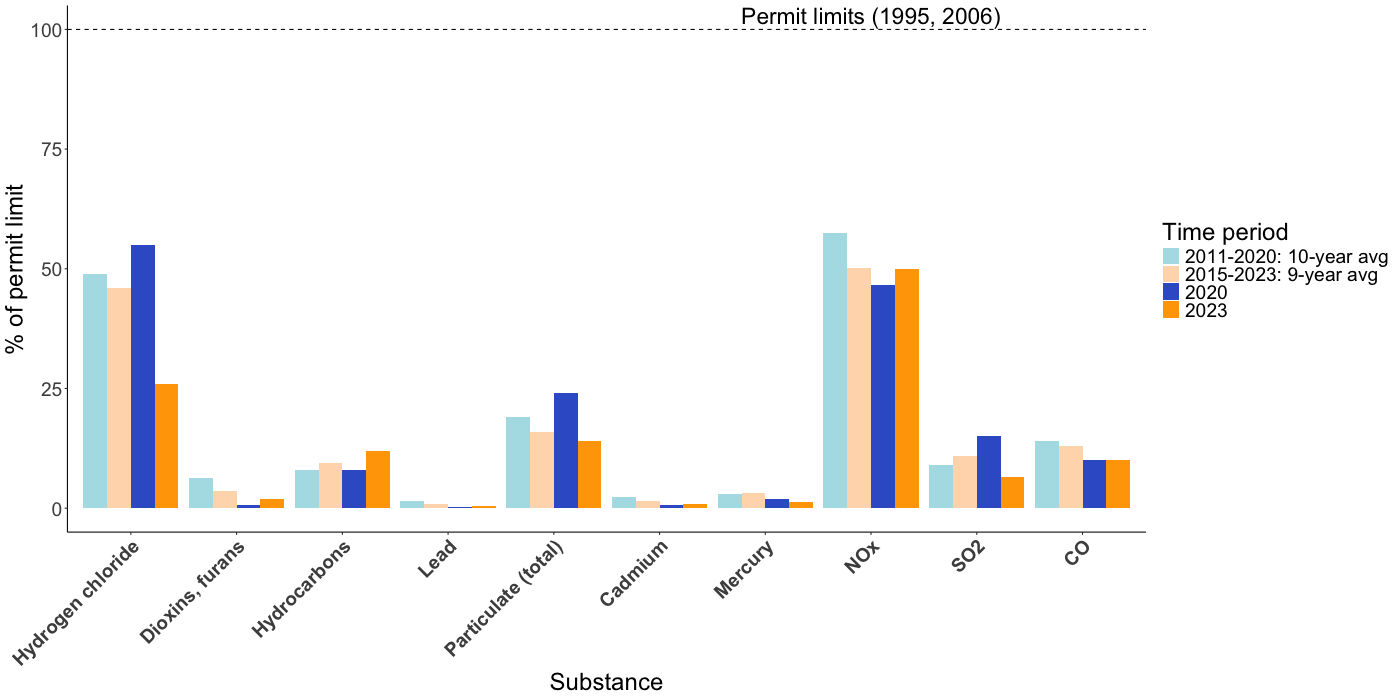
However, the MN Pollution Control Agency (MPCA) issued the HERC’s permit in 1998, close to 30 years ago. Since then, updates have only been made in 2006 to cadmium, mercury, and lead limits (EPA 2024). Making safety claims using only these permit limits is linked to several points of concern.
Concern 1: HERC’s permit limits are NOT based on health standards
As discussed above*, the first phase of hazardous pollutant regulation is a technology-based phase in which pollutant limits are set based on the capacities of available pollution control technology, so called maximum achievable control technology (MACT) standards. These limits may not necessarily align with levels that are safe for health.
The second phase of hazardous pollutant regulation (the residual risk assessment) evaluates health risks after MACT standards have been applied, but this phase has not been carried out for municipal waste incinerators. (This residual risk assessment was supposed to have taken place in 2003, 8 years after the 1995 MACT standards were set.)
Concern 2: HERC’s permit limits are based on improperly set EPA limits
In 2008, the Sierra Club petitioned the EPA over MACT limits at a federal district court (EPA 2024). They argued that the EPA’s MACT limits were based in part on state-level air pollution permits, rather than on the average emissions from the best 12% of facilities of the same type (the CAA’s stipulation). Thus, it cannot be accurately claimed that the EPA’s pollution limits (which were used for HERC’s permit) were as stringent as they should have been.
Concern 3: HERC’s permit limits are outdated and less stringent than modern standards
In 2024, the EPA proposed new air pollution limits (MACT limits) for municipal solid waste incinerators (EPA 2024). The figure below shows how HERC pollutant levels would compare to these new proposed limits. The black dashed lines reflect new limits for existing incinerators (such as HERC), and the red dashed lines reflect new (more stringent) limits for incinerators built in the future. While the black lines would legally apply to HERC, the red lines are what would apply if the best available pollution control equipment was required for HERC.
Under the strictest limits (red lines), several HERC pollutants (namely, hydrogen chloride, particulate matter, nitrogen oxides, and carbon monoxide) exceed or are close to exceeding these limits.
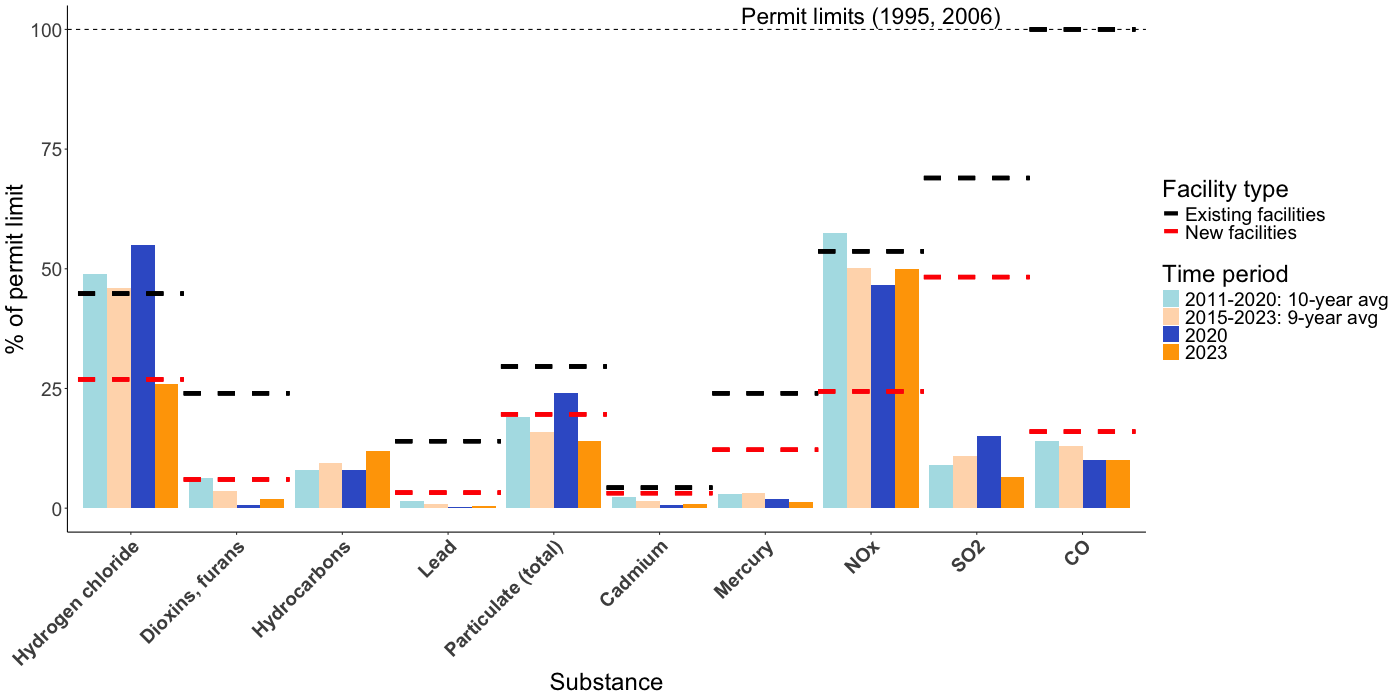
The tables below show how HERC pollutant levels would compare to updated permit limits (as a percentage of the permit limit):
Concern 4: Air pollution permits ignore the simultaneous health impacts of multiple pollutants
The importance of assessing the health impacts of air pollution mixtures has only recently gained appreciation, and analytical methods for assessing these impacts are being actively developed. As we wait for the development of scientific literature on health impacts of complex air pollution mixtures, we can gain some preliminary understanding by looking at existing literature on interaction effects of a few factors at a time.
Anenberg et al. (2020) examine three factors (air pollution, air temperature, and pollen levels) and perform a systematic literature review to assess evidence for synergistic effects of combinations of those factors. They find evidence for a synergistic relationship between heat and air pollution (particularly ozone and particulate matter) on all-cause mortality, cardiovascular outcomes, and respiratory outcomes. From these results, it is reasonable to believe that different air pollutants have synergistic effects as well. Thus, it is important that air pollution limits are even more stringent to compensate.
Concern 5: History calls for taking a precautionary approach
The following figure of the HERC’s mercury (Hg) concentrations over time illustrates the impacts of our changing understanding. While mercury emissions have always been below regulatory limits in place at the time, we can see that in early years, county residents were exposed to mercury levels that were much higher than currently permissible levels.
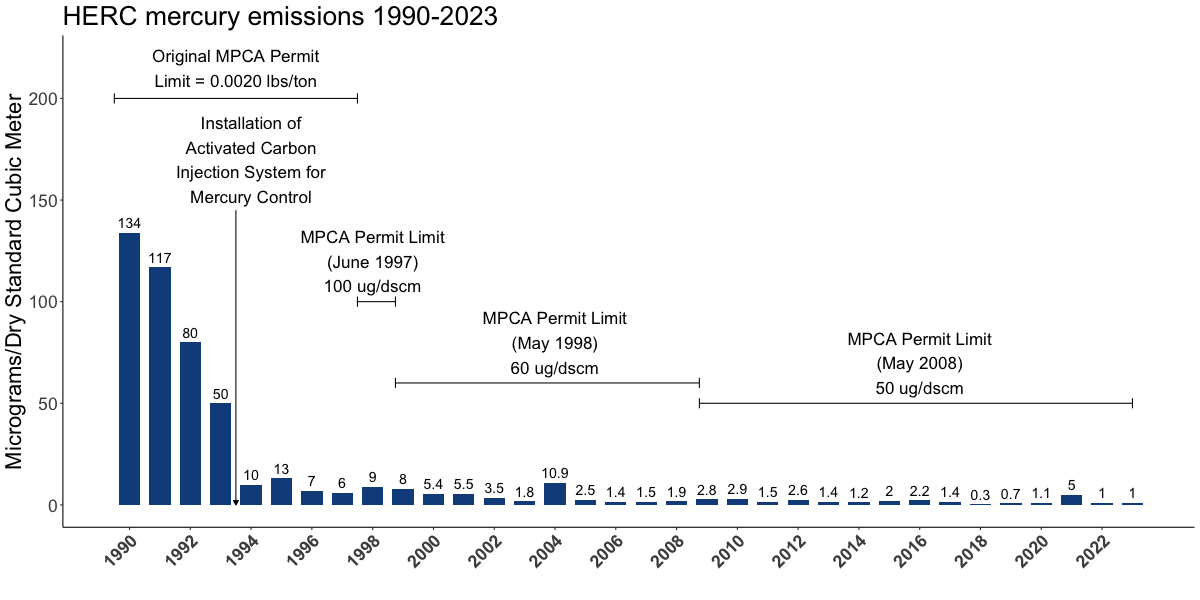
Stricter standards have also been seen for particulate matter and nitrogen dioxide.
Particulate matter: The CAA primary standard for PM2.5 was 15 µg/m3 in 1997, lowered to 12 µg/m3 in 2012, and lowered again to 9 µg/m3 in 2024 (EPA 2025b) The World Health Organization (WHO) has proposed even stricter standard of 5 µg/m3 (WHO 2021), which is 3 times lower than the 15 µg/m3 set for the HERC when its permit was approved based on the 1997 U.S. EPA standards.
Nitrogen dioxide: The CAA long term standard for NO2 has not changed since 1971 when it was set at 53 ppb, last evaluated in 2018 (EPA 2025a). The short-term (1 hour) standard was first set in 2010 at 100 ppb and has not changed since. By contrast, the WHO standard for long-term exposure was reduced to 18.8 ppb in 2021 from 75 ppb in 2005 (WHO 2021). The short-term (24-hour average) of 47 ppb was also set in 2021.
Recognizing that as time goes on, new scientific understanding will likely warrant lower permissible levels of pollutants, policy can proactively anticipate these necessary reductions by aligning with the precautionary principle. The precautionary principle is a guideline for legal decision making that acknowledges that waiting for scientific certainty increases risk for current harms and that knowledge of present and future risk warrants acting sooner.
The precautionary principle is part of European Union law but is not used to the same extent in the United States.
What equity considerations are of concern for HERC pollutants?
The map below shows the percentage of cancer risk that is estimated to be attributed to HERC pollutants based on data extracted from County presentations*. Risk is highest close to HERC and lower farther away.
- The two blue circles represent 1 and 2-mile areas surrounding HERC. Keep these areas in mind as you explore maps of local area characteristics later on this page.
- Tracts outlined in red are environmental justice (EJ) communities*.
- Tracts with yellow asterisks indicate the tracts for which the county showed data in their presentations.
- The county did not display a map of this spatial information, but even if they had created a map using only data for the yellow-starred tracts, the clear decline in risk with greater distances from the HERC would not be apparent. The inclusion of further tracts like Golden Valley and Lynhurst/Kenny make this disparity clear.

The map below is analogous to the one above but for non-cancer diseases. We see the same pattern of highest risk close to HERC.
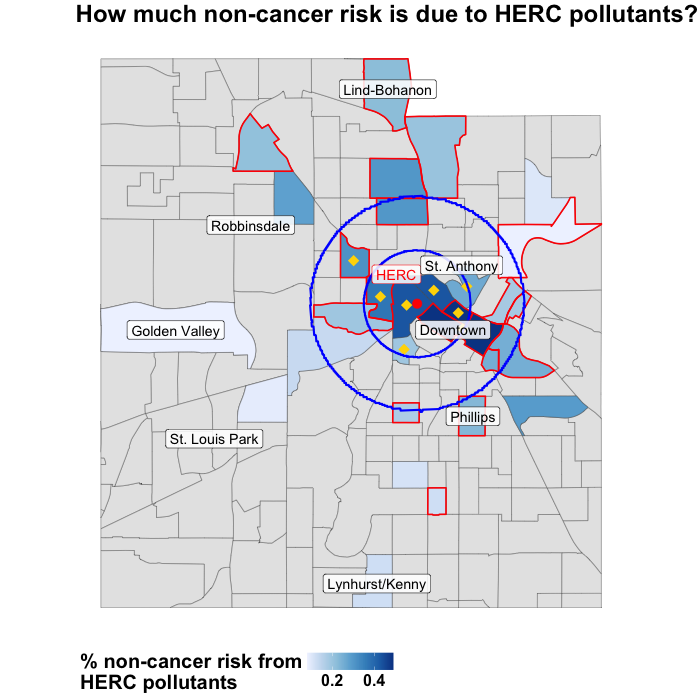
The boxplots below reinforce the large change in disease risk with distance. The thick horizontal lines represent the median percentage of risk due to HERC pollutants and show a clear decline with greater distance.
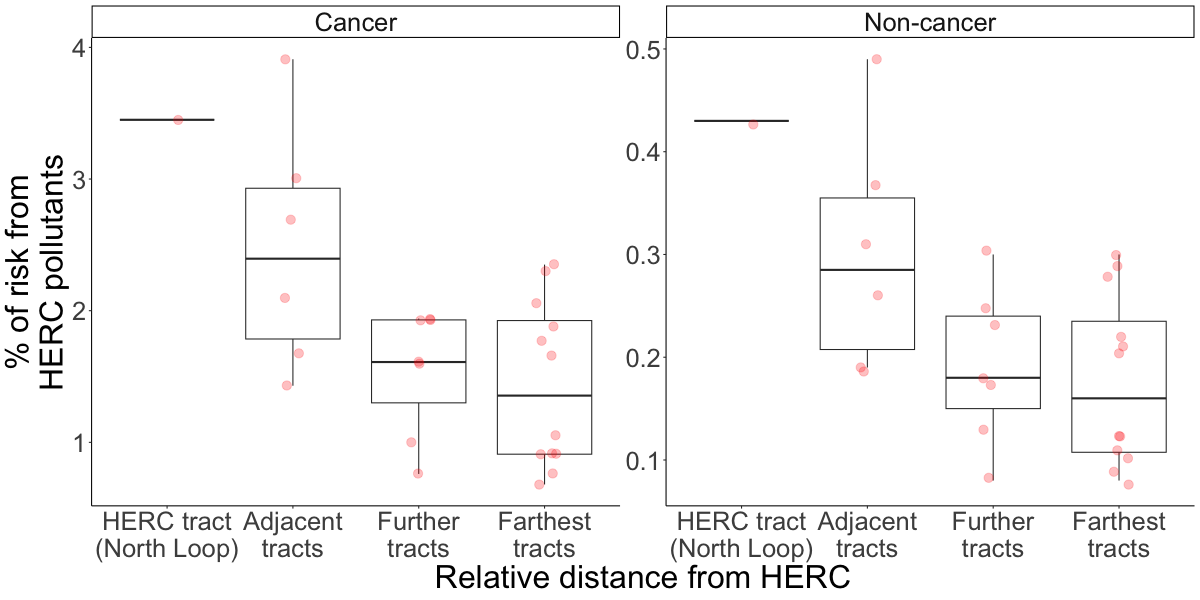
The boxplots below directly compare environmental justice (EJ) tracts with non-EJ tracts.
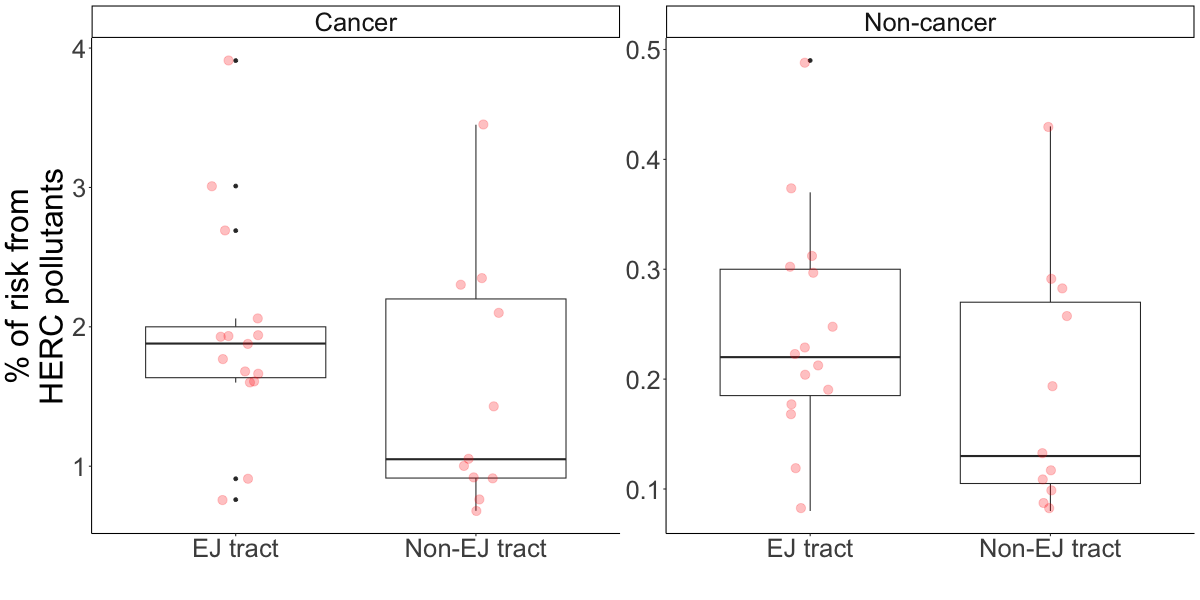
Examining health risks for EJ tracts is important because science shows that people in EJ communities are also at higher risk from a given amount of air pollution than those in non-EJ communities. The risk differences shown in the above boxplots do not include these additional risks for EJ communities. In a later section, we review findings from the scientific literature on the increased susceptibility of EJ communities to health impacts.
Who lives close to HERC?
The map below displays social, health, environmental, and climate burden characteristics of census tracts around HERC (blue pin). There are many tracts with high burden within 2 miles of HERC. The combination of these high burdens and high disease risk from HERC pollutants creates a serious environmental justice concern.
Use the layers toggle in the top right to switch between these 4 indices. Index values range from 0 to 1 with numbers close to 1 indicator greater burden. You can click on a tract to see the its index value.